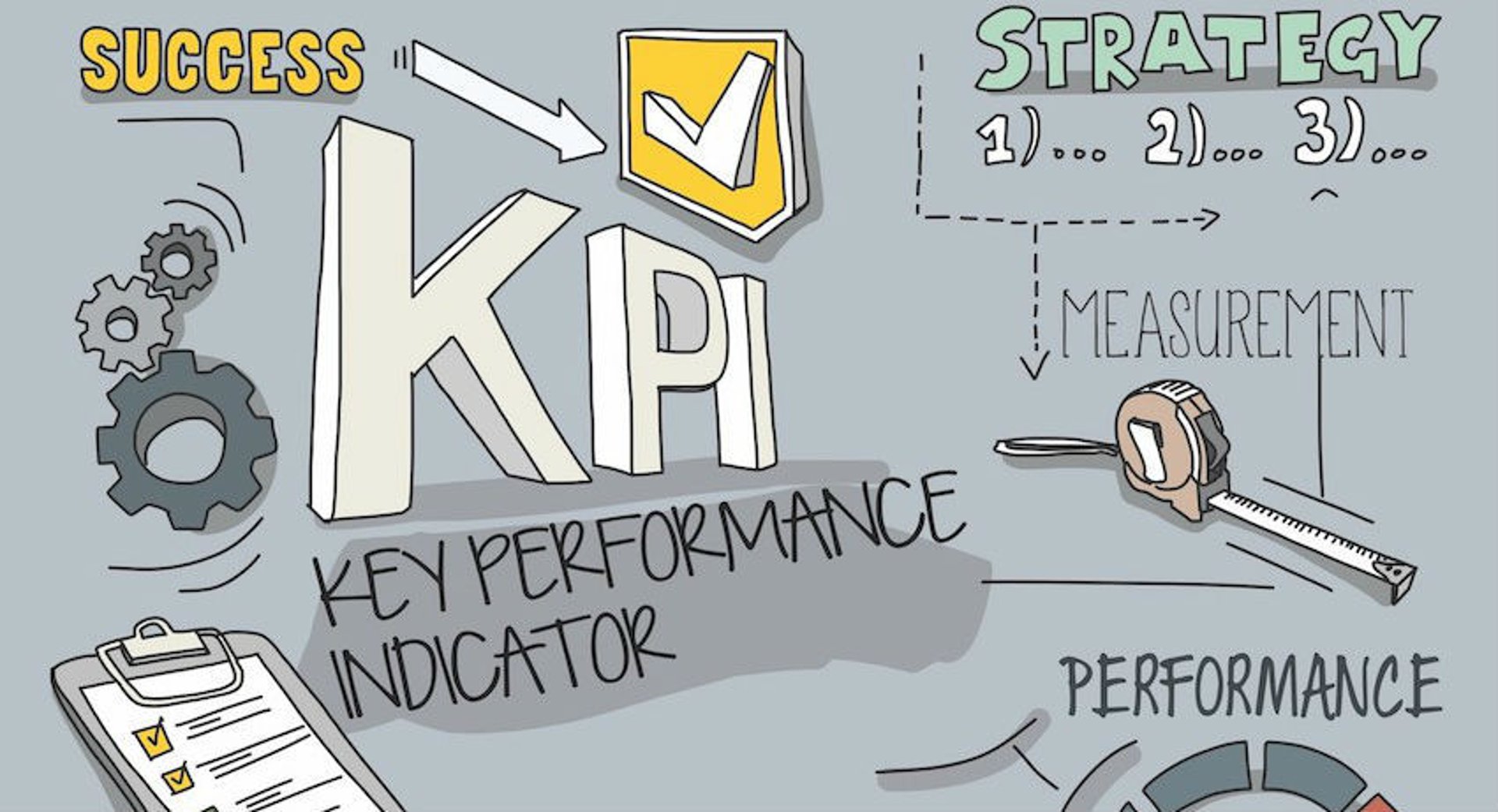How To Define Your KPIs

Published 2024-03-18
Summary - "How do we define our organization's KPIs?" Get the tips to help define and gain alignment around your organizational KPIs.
Success in business often seems like aiming at a moving target. One minute, you’re focusing on customer satisfaction; the next, you’re monitoring employee productivity. The underlying goal, though, is to make sure your business is moving forward.
That’s why it’s important to define KPIs and establish clear ways to measure the effectiveness of your strategies. Key performance indicators (KPIs) guide you toward your business goals through data.
Whether you’re a burgeoning startup or an established enterprise, you should know how to define KPIs and leverage them to stay on track toward achieving your business objectives.
What are KPIs?
Key Performance Indicators, or KPIs, are the benchmarks that pave the way for your organization’s success. These quantifiable indicators always point to an intended result. When you define KPIs effectively, you can measure how well your team reaches their specific goals.
The key is to choose KPIs that are closely linked to your strategic goals and that provide insights into your business’s performance. This means not all metrics will qualify as KPIs, only those that indicate your progress towards important business outcomes.
Importance of key performance indicators in business strategy
KPIs help you align action with strategy and measure progress and performance. As a result, you can make informed decisions and drive improvement and innovation in your organization by enhancing communication and focus.
Aligning actions with strategy
KPIs serve as a bridge between your daily operations and your long-term objectives. By defining KPIs, you create clear benchmarks for which everyone in your organization can aim.
These benchmarks are directly tied to your strategic goals so that every team member’s efforts contribute meaningfully to the business’s overarching ambitions. When you clearly define KPIs, you set a standard for what success looks like, making it easier for everyone to understand their role in achieving it.
Measuring progress and performance
One of the core values of KPIs is their ability to measure progress. They are the metrics that you monitor regularly to determine if your business is on the right path.
When you keep an eye on these key performance indicators, you can see how close you are to achieving your strategic goals. It’s through this ongoing measurement that you can react swiftly if things aren’t going as planned.
For instance, if your KPIs are not meeting their targets, you can quickly adjust your strategies or operations to get back on track.
Informing decision-making
KPIs provide you with factual, data-driven insights that can help you make informed decisions. Whether it’s deciding where to allocate resources, when to launch a new product, or how to improve operational efficiencies, your KPIs offer the evidence needed to make choices that are aligned with your strategic objectives.
This way, every decision you make is grounded in solid data, reducing guesswork and enhancing the likelihood of success.
Driving improvement and innovation
When you regularly review your key performance indicators and the results they show, it encourages your team to look for ways to improve those numbers. This can lead to innovative approaches to work, process optimizations, and overall enhancements in how your business operates.
The constant pursuit of better KPI results can drive your organization to continually refine its strategies and operations, leading to sustained long-term success.
Enhancing communication and focus
KPIs drive success for every organization since they make it easier to communicate priorities, progress, and challenges. This shared understanding helps foster teamwork and maintain a focused approach to achieving business objectives.
By making KPIs a central aspect of your business strategy, you create a common language that everyone in the organization can rally around.
KPIs vs Metrics vs OKRs
KPIs, metrics, and OKRs serve distinct purposes in guiding and evaluating business performance. KPIs are tied directly to strategic goals and are meant to show where you need to improve and where you excel. They’re a measurable value that helps organizations track and evaluate their progress toward specific objectives.
Metrics are still quantitative measures but broader. Technically, all KPIs are considered metrics, but not all metrics are KPIs. These can represent any data point relevant to your business’s success, including sales revenue, customer engagement, or employee productivity.
Metrics can also vary significantly depending on the department, project, or scope.
Objectives and Key Results (OKRs) are a framework for defining and tracking objectives and their outcomes. They’re often confused with KPIs but typically set on a quarterly basis.
OKRs push beyond the current performance levels. Meanwhile, KPIs tend to be more ongoing. They’re used to monitor the overall health of the organization, particularly in achieving its core goals.
The main difference between KPIs, metrics, and OKRs lies in their scope and intent. KPIs are strategic indicators meant to track and measure the success of the organization’s most crucial goals.
Metrics, while also quantifiable, can relate to any aspect of a business and are not always tied to strategic objectives. OKRs combine goal-setting theory with a structured approach to achieve specific objectives, often used to catalyze growth and change within an organization.
What should be a key performance indicator for your company?
When we define KPIs, it’s not just about looking at what other companies are doing. It’s about identifying the specific indicators that matter most to your company’s unique goals and objectives.
Regardless of what industry you’re in, you should define KPIs that are SMART (specific, measurable, achievable, relevant, and time-bound).
Specific
A KPI must be specific, clearly defining what you aim to measure. This way, you focus your team’s efforts on achieving exact outcomes.
For example, rather than aiming for an increase in sales, a specific KPI would be increasing online sales by 15%. This specificity helps everyone in the organization understand exactly what is expected and can direct their efforts toward achieving that specific target.
Measurable
A KPI also needs to be measurable. This means you should be able to attach numbers to it, such as percentages, quantities, or frequencies.
For instance, if your goal is to improve customer satisfaction, a measurable KPI could be to achieve a customer satisfaction score of over 90%. Having measurable KPIs lays out the criteria for success clearly and allows for tracking progress effectively.
Achievable
Setting achievable KPIs is also crucial for maintaining motivation and momentum. An achievable KPI is one that is challenging yet practical—it should stretch your team’s capabilities but remain within reach with enough effort.
Setting unattainable KPIs can only lead to frustration and disengagement. On the other hand, realistic KPIs can motivate your team to strive for excellence. They should inspire improvement and drive progress, all while considering your current resources, capabilities, and market conditions.
Relevant
When you define your KPIs, make sure they align with your company’s strategic objectives. They should also address core elements that contribute to your business’s success.
A relevant KPI makes sure that you are measuring what matters, focusing your efforts on factors that directly impact your strategic goals.
For instance, if expanding into new markets is a priority, a relevant KPI could be “capture three new international markets this year.” This way, your team’s efforts are concentrated on activities that will lead your company to its overarching goals.
Time-bound
Lastly, a KPI should have a clear deadline or timeframe for achievement. Time is a critical aspect of business, especially when you want to take advantage of urgent opportunities.
For example, setting a KPI to increase monthly leads by 20% by the end of Q2 establishes a clear timeline for assessing progress and effectiveness. Time-bound KPIs pave the way for regular reviews and adjustments. They make sure your strategies remain dynamic and responsive to your business’s needs.
Tools for defining KPIs
Various tools, like business intelligence systems and data analytics platforms, can help you define KPIs effectively. These tools can help you look at data from different perspectives and gain valuable insights to choose the right key performance indicators to prioritize.
Data analytics platforms
Data analytics platforms analyze huge amounts of data to extract insights. These help you understand historical trends, current performance, and potential outcomes.
With these tools, you can move beyond gut feelings so that your KPIs are grounded in reality and capable of providing a true measure of your organization’s progress.
Benchmarking software
Benchmarking software, such as HWMonitor and 3DMark, is a tool that provides comparative data on your business’s performance against peers and industry standards. Knowing where you stand market-wise is crucial for setting realistic yet challenging KPIs.
It helps you understand your areas of strength and opportunities for improvement. By knowing what top performers in your industry are achieving, you can set KPIs that push your organization toward excellence.
Business intelligence systems
Business intelligence (BI) tools, like Klipfolio, offer you a way to analyze current and historical data easily. We can help you define KPIs by shedding light on patterns and trends that might not be visible through manual analysis.
With BI systems, you can generate reports and dashboards that offer insights into various aspects of your business, helping you identify the most relevant metrics to track as KPIs.
For instance, if you run an e-commerce business, PowerMetrics can help you track crucial e-commerce KPIs, such as website traffic, conversion rates, average order value, and customer retention rate, in real time. This way, you can spot specific marketing trends that are driving more traffic or certain products that are more popular.
With this information, you can continue to optimize your marketing and product development strategies to boost online sales.
Survey tools
Survey tools, like Typeform or SurveyMonkey, are useful for gathering feedback from employees, customers, and other stakeholders. With surveys, you get firsthand insights into areas that should be monitored through KPIs.
For employees, you can gather feedback on what parts of the process they usually track closely. This feedback can help you define KPIs that can make their jobs easier.
Similarly, getting feedback from customers can show areas in the sales journey that require improvement or optimization. This can lead to creating KPIs that focus on keeping customers satisfied and retaining their loyalty.
Techniques for defining KPIs
Aside from using the right tools, you should also employ the best practices for identifying your key performance indicators to maximize the efficiency and accuracy of your KPI selection process.
Check your current stage of growth
Understanding your organization’s current stage of growth is important in defining relevant KPIs. Different stages, whether you’re a startup, in a growth phase, or established, will have different priorities and focus areas.
Startups might focus on KPIs related to market penetration and customer acquisition, while established businesses might track customer retention or market share.
Determine where your business is in its lifecycle. Knowing this will guide you in defining KPIs that are appropriate for your current challenges and opportunities. For a new company, rapid user growth might be crucial, whereas a mature company might prioritize operational efficiencies or expand into new markets.
Find specific problems or issues
KPIs should be tools for solving your business’s specific problems or addressing particular issues. Begin by conducting a thorough analysis of your business operations to pinpoint areas that require improvement or where achieving excellence could provide significant leverage.
Whether it’s reducing customer churn, improving profit margins, or enhancing employee productivity, your KPIs should directly relate to these focal points, enabling you to measure the impact of strategies implemented to address these issues.
Categorize KPIs as leading or lagging
Understanding the difference between leading and lagging KPIs can significantly enhance your strategic monitoring. Leading KPIs are predictive indicators that can forecast future trends or outcomes, like an increase in website traffic indicating potential future sales growth.
Lagging KPIs, on the other hand, measure the output of past activities, such as quarterly sales figures. Balancing both types provides a comprehensive view of your performance.
With these, you can combine insights from leading indicators with the solid, retrospective data of lagging indicators.
Identify and avoid vanity metrics
Vanity metrics are appealing because they look good on paper, but they don’t necessarily correlate with your business’s success. They can be misleading and may divert attention from genuine growth indicators.
You must differentiate between what feels good to report and what genuinely matters to your business’s health. Focus on KPIs that directly impact your strategic goals and bottom line, such as customer lifetime value or conversion rates, rather than superficial metrics like page views or number of followers, unless they directly tie to your business outcomes.
Setting up key performance indicators
Now, it’s time to choose and set up your KPIs. Here are the relevant aspects to consider when establishing them:
Understand your strategic objectives
Before defining any KPIs, you must have a clear understanding of your organization’s strategic objectives. KPIs should directly reflect these goals, providing a measurable way to track your progress towards achieving them.
Make sure that each KPI you select is closely aligned with your overarching business aims so that every metric you monitor contributes to your strategic success.
Define clear, specific KPIs
Each KPI should be defined clearly enough that anyone in the organization can understand what it measures and why it’s important. For example, if you want to track conversion rates, make sure to specify whether it’ll be for overall website conversions or specific product pages.
This way, you can eliminate confusion and make sure that everyone is aligned on what constitutes success and what areas need focus and improvement.
Keep KPIs measurable
A key aspect of KPIs is their measurability. You need to make sure that you can quantify each one, whether it’s through financial figures, percentages, ratios, or other numerical data.
As mentioned, measurable KPIs allow you to assess your performance objectively and track changes over time. As a result, you can provide a solid basis for data-driven decision-making.
Align KPIs with industry standards
Your KPIs should reflect not only your internal objectives but also industry standards. This alignment keeps your performance indicators relevant and competitive within your industry context.
With these benchmarks, you see where your organization stands and can implement strategies accordingly.
Make KPIs achievable
While KPIs should be challenging, they also need to be achievable. Setting unrealistic KPIs can demotivate your team and create a sense of failure.
Keep your KPIs ambitious yet attainable, balancing between motivating your team and providing targets that are within reach.
Review and update KPIs regularly
Regular monitoring of your KPIs can help you stay aligned with your goals and keep operations effective.
However, don’t take it too far and become obsessed with daily checks. Instead, create a consistent review schedule that aligns with your business cycles and decision-making processes.
Whether it’s weekly, monthly, or quarterly, tracking your KPIs regularly enables you to stay on top of performance trends and adjust strategies promptly to meet your defined objectives. It also helps in fostering a data-driven culture within your organization, where decisions are made based on empirical evidence and strategic foresight.
Involve your team
Engage various departments and team members to gather input so that your KPIs are well-rounded and have broad support within the organization. Plus, doing so also fosters a sense of ownership and accountability.
Leverage technology for tracking
Various software and tools can automate data collection, provide real-time analytics, and display your KPIs on dashboards for easy monitoring. For instance, PowerMetrics is a no-code solution that lets anyone in your organization create data visualizations and share insights easily.
These tools can help you stay on top of your performance metrics to make informed decisions quickly.
Tracking and evaluating KPIs
It’s not just about defining and setting up your KPIs. As mentioned, you should monitor and update them regularly.
As your company grows, your organizational needs will change. Thus, you should assess whether the KPIs you’re monitoring are still relevant to your requirements.
Establish a regular review schedule
Again, you must have a regular schedule for reviewing your KPIs. Consistent evaluation helps you keep a pulse on your organization’s performance and react swiftly to any changes in your metrics.
Stay on top of KPI trends
Don’t just look at your KPIs in a snapshot; analyze them over time to identify trends, patterns, and anomalies. This longitudinal analysis can reveal insights that single data points cannot, such as seasonal variations or emerging challenges.
Understanding these trends can help you make strategic adjustments to your strategies.
Lead team discussions around KPIs
KPI reviews are a collaborative effort. Discuss and brainstorm with your team about KPI performance, implications, and the succeeding actions. These meetings can provide you with diverse perspectives and solutions. They also encourage accountability among team members.
Adjust KPIs as needed
Be prepared to adjust your KPIs if they no longer serve their intended purpose or if your business objectives change. Again, KPIs should be dynamic and flexible, evolving with your business.
Regular evaluation might reveal that certain KPIs are no longer relevant or that you need to track new ones to address potential business priorities or market conditions.
Integrate KPIs into business processes
Make KPI tracking part of your processes so that being data-driven becomes a natural and consistent part of your organizational culture. This way, you can keep everyone focused on achieving key objectives and driving business success.
Common KPI mistakes
Even the most successful organizations can fall into the trap of making common KPI mistakes. These errors can occur at any stage of a company’s development, such as when new team leaders come on board or when new goals are set.
Reliance on intuition
Many leaders might rely too heavily on their intuition when it comes to KPIs. While knowledge and experience can hone a leader’s quick decision-making, going for purely gut feel can be dangerous for your company.
It often stems from the overconfidence effect, where one’s subjective confidence in their judgments is greater than their objective accuracy. Intuition shouldn’t be the sole basis for defining or interpreting KPIs.
You need to see the data as it is and make decisions based on empirical evidence and strategic foresight.
Adopting common best practices without customization
Different companies have different goals and needs. It’s a common mistake to adopt universally recognized best practices and KPIs without tailoring them to your organization’s specific context.
While these can provide a solid starting point, your KPIs should be customized to align with your unique business objectives and operational realities. When you define KPIs, make sure they’re relevant and not just reflecting generic industry standards.
Bias toward recent information
It can be tempting to prioritize the most recent information rather than take the time to study past data for a more comprehensive view. This recency bias can lead to short-sighted decisions or misinterpretation of KPI trends.
Make sure to consider both historical and current data when evaluating KPIs. This way, you can employ a balanced and informed approach to decision-making that accounts for longer-term trends and patterns.
Confusing lagging and leading indicators
A critical mistake in KPI selection pertains to confusing lagging indicators with leading indicators. Lagging indicators are often easier to measure because they represent outcomes or results that have already occurred.
Conversely, leading indicators, which are predictive measures, are typically harder to quantify. Just like past and current data, you also need to have a balance between lagging and leading indicators to gain insights into past performance and a view of potential future trends.
Overlooking the evolution of KPIs
KPIs should not remain static, especially in industries that are rapidly changing. Holding onto outdated KPIs can lead to a mismatch between what you’re measuring and what your business currently needs to focus on. That’s why you should review and update your KPIs regularly to reflect new objectives and market conditions.
Lack of clear KPI definitions
Without clear definitions, KPIs can be misunderstood or misinterpreted by different members of your team. Make sure that each KPI is clearly defined, with specific criteria for measurement, so that everyone in the organization has a unified understanding of what is being measured and why it matters.
Ignoring data quality
The accuracy and reliability of your KPIs depend heavily on the quality of the underlying data. Poor data quality can lead to incorrect conclusions and misguided decisions.
Keep data sources reliable and consistent. For example, you should set a standard process for adding contacts in your CRM. Regular audits are also important to spot anomalies, such as duplicate entries.
Neglecting regular KPI reviews
Don’t forget to set regular KPI review schedules. KPIs should be regularly reviewed and revised as necessary to ensure they remain relevant and aligned with your business goals. As mentioned, discuss the implications with your team to guide future strategies.
Keeping In Stride with KPIs
KPIs can show you the strengths and weaknesses of your company. Once you have the right information, you can then analyze the parts that need attention and focus on enhancing processes or strategies to boost performance in these areas.
FAQ
Are KPIs really effective?
Yes, KPIs can be highly effective when they are well-defined and properly aligned with strategic goals. They provide a focused insight into the organization’s performance so that leaders can make data-driven decisions.
However, their effectiveness largely depends on selecting the right KPIs and setting appropriate targets. Plus, you must review them regularly to make sure they remain relevant and in line with your business objectives.
Which KPI is most important?
The most important KPI is the one that will guide your organization straight to its strategic objectives. It varies from one business to another, depending on your specific goals, industry, and focus.
That’s why you must define KPIs that reflect your critical success factors and provide actionable insights into your performance. The priority of a KPI should be determined by its relevance to your core objectives and its impact on your overall business success.
Who sets the KPI?
Ideally, KPIs should be a collaborative effort involving key stakeholders, including senior leadership, department heads, and even team members.
With this collaborative approach, you get SMART KPIs that can help you steer your organization to where you want it to go.
Related Articles

2025 BI and Analytics Trends for Small and Mid-Sized Businesses
By Allan Wille, Co-Founder — December 18th, 2024
Let’s fix analytics so we can stop asking you for dashboards
By Cathrin Schneider — September 11th, 2023
Guide to migrating your digital marketing dashboards to Google Analytics 4
By Jonathan Taylor — February 13th, 2023

